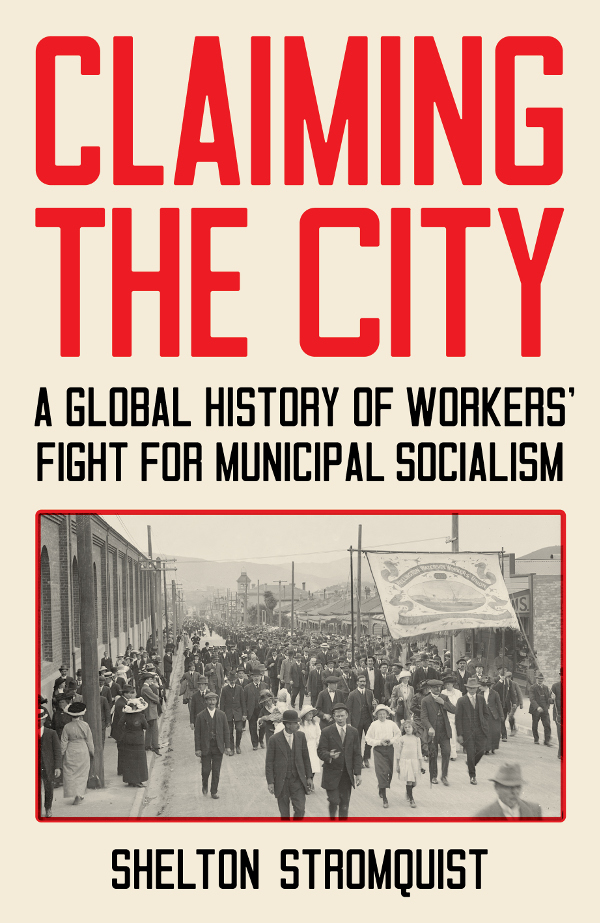A hundred years ago, the working people of Vienna, Austria could boast that, five years after the devastation of World War I, their city government was building a “New Vienna” for workers. The city was aggressively tackling an acute housing crisis by building tens of thousands of affordable units of “social housing.” Taxes were being restructured so that the wealthy paid their fair share, and those funds were being used to improve public health and meet the economic, educational and cultural needs of working people. Their efforts were gaining international renown — a labor paper from half a world away, the Brisbane Worker in Australia, called the city “The most well-cared for, the cleanest, the healthiest and the most beautiful city in the world.”
In his new book Claiming the City: A Global History of Workers’ Fight for Municipal Socialism, labor historian Shelton Stromquist describes these achievements as the culmination of decades of agitation around a program that was “essentially identical” to programs pursued by workers around the world. In the decades before the war, the equivalent beacon for working-class parties around the world was Milwaukee, Wisconsin, where the Social Democratic Party had won control of the city in 1910. With control of the mayor’s office, the city council, and the county council, the Social Democrats “largely succeeded” in implementing important parts of their program: bringing the street cars and other city services under public ownership, building public markets, parks and swimming pools, establishing free medical dispensaries and hospitals, and providing free textbooks to schoolchildren.
As that list demonstrates, the “municipal socialism” of the book’s title encompasses many things we take for granted today — though they are often under attack. Among the achievements of the labor government of Broken Hill, Australia in 1900 were the paving of streets, improvement of parks, street lighting and a public library. In addition to expanding the public sector to meet the needs of working people, municipal socialists agitated for government oversight to ensure safe and sanitary food and housing, transparency in city government, and expanded voting rights.
One of the most notable parts of the municipal socialist program, one that comes up in city after city, is the demand that municipal workers be paid a living wage and provided with decent working conditions, including the eight-hour day. Decades — in many cases more than half a century — before U.S. states began passing laws enabling collective bargaining for public-sector workers, these working-class parties saw setting labor standards for municipal workers not just as the right thing to do, but as an important way to push up standards for the whole working class.
“Something new in the air”
Stromquist’s history begins in a way some might find surprising in a book about municipal politics: with a wave of strikes. He writes that “Something new was in the air by the late 1880s,” and details a “global strike wave” reaching from maritime workers and sheepshearers in Australia to railroad workers and miners in the U.S. to shoemakers in Sweden.
The outcomes of these strikes often depended, in part, on the actions of local and state governments. Stromquist writes, “The entry of the state through court injunctions and the deployment of the police or the military forced workers to consider their status as citizens as well as strikers.”
Cities were especially important places for workers to consider their status as citizens. They were the places where workers and their families worked, lived, and suffered from low wages and long hours, poor and crowded housing conditions, adulterated and expensive food, and other indignities. They were also the places where workers experienced social solidarity, and could imagine using their greater numbers to transform their lives by participating in the political process.
Overcoming Limitations on Democracy
The elites who governed cities, however, had long feared that working people would do precisely that — use their greater numbers to demand that the wealth of cities be used to benefit all who lived there, not just a small number of landlords and capitalists.
One of the great strengths of Claiming the City is how its international perspective helps us understand the history of our own country. In other countries, municipal elections were conducted in extremely undemocratic ways until well into the twentieth century, with voting systems that explicitly gave greater representation to those with more wealth, and in many cases excluded the poorer sections of the working class entirely.
In the U.S., where universal suffrage for white men was well-established by the mid-19th century, urban elites had to be more creative in their efforts to blunt working-class power in cities. One result of this was the rise of urban “machine” politics, where the wealthy essentially agreed to share power with a party organization (often, though not always, the Democratic Party) which would distribute patronage — though not power — to its working-class constituency.
A more ingenious solution, and one which would also reduce the power of the machines, was switching to “at-large” elections and a “city manager” form of government. By making all seats on local governing bodies “at large,” the new city charters promoted by business interests deprived voters in working-class wards the ability to have their specific interests represented in city government. “City managers” hired by city councils (often renamed as “city commissions”) were much more insulated from popular pressure than the elected mayors they replaced.
Stromquist demonstrates how this played out in two cities in Ohio, the U.S. state which elected more socialists to local office than any other in the first part of the 20th century. In Hamilton, socialists elected a five-person working-class majority of the city council in 1911: two machinists, a painter, and two stove-manufacturing workers. In 1913, they successfully elected a mayor in a three-way race. Although they lost control of the city when Democrats and Republicans united to defeat them in 1915, they remained a significant force in city politics, helping to defeat efforts to privatize municipal electric and gas utilities and, perhaps more importantly, repeated efforts to establish at-large elections and a city manager form of government.
In nearby Dayton, by contract, the election of two socialist city councilors (out of a council of 15) in 1911 so frightened local employers that they pushed through a charter change in 1913. As Stromquist writes, ‘the new charter long sought by the city’s Chamber of Commerce and its powerful “open shop” employers’ association established a “businessman’s government,” now insulated by a professional city manager and a small city commission elected on an at-large basis.’ Despite winning 43 percent of the vote city-wide in 1917, Dayton’s socialists won no seats on the new commission, and the “businessman’s government” felt no need to respond to their demand for an eight-hour day and minimum daily wage for municipal workers.
Internationalism from Below
Despite these machinations by propertied urban elites, municipal socialists in the U.S. saw more success in the years before World War I than their counterparts elsewhere — and some of them left to spread the “gospel of labor and socialist radicalism around the world.”
Some of the most interesting characters in Stromquist’s book are the “far-flung cadre of locally grounded internationalists” who would travel, sometimes for years at a time, from their home countries to other places to share their experiences and learn from others. Their travel, their correspondence, and their coverage of workers’ struggles elsewhere in the world in working-class papers produced “[r]emarkably congruent political programs” as working-class and labor parties contested for control of cities across the world.
This “internationalism from below” was damaged — though not, Stromquist argues, destroyed — by the outbreak of World War I. Socialist and labor parties in many of the warring countries endorsed their respective governments’ war efforts to varying degrees, abandoning their stated commitment to peace and internationalism. However, municipal socialists, regardless of their position on the war itself, were on the front lines of fighting the many hardships the war imposed on the working class of all countries.
It is here that the story of municipal socialism in the U.S. diverges most sharply from that in other countries. Although the U.S. did not enter the war until 1917, employers and urban elites saw it as “a convenient opportunity to mobilize a broader public against their longstanding labor and socialist foes.” In other countries the fights that labor and socialist parties waged for housing, adequate food, and public welfare — especially for the families of those fighting at the front — positioned them to win elections after the war, most dramatically in Vienna. In the U.S., by contrast, violent repression of socialists and trade unionists during the war and the postwar “red scare” of 1919-20 largely put a halt to the advances made by the working class, in both urban governance and organizing unions, before the war.
Claiming the City Today
In a brief epilogue, Stromquist reviews how the struggle for municipal socialism in the late 19th and early 20th century informed working-class and anti-colonial struggles over the course of the 20th century, and how it informs current struggles for fair wages and fair housing in U.S. cities today.
As housing in the U.S. has become increasingly unaffordable for all but the wealthiest, especially in urban areas, the example of the social housing built in “Red Vienna” (and by socialist city administrations after World War II) has even gotten positive notice in the mainstream press. No less of a voice of the establishment than the New York Times published an article titled “Imagine a Renter’s Utopia. It Might Look Like Vienna” in May.
Indeed, some of the most promising political developments for the working class in recent decades have come from cities. In Pittsburgh, close UE allies Ed Gainey and Sara Innamorato have won election as mayor and county executive on platforms reminiscent of the municipal socialism described in Claiming the City. In Chicago, the Chicago Teachers Union built a powerful working-class political movement in the wake of their 2012 strike. This past spring that movement (which UE is part of) elected former CTU organizer Brandon Johnson as mayor of the third-largest city in the U.S. Bernie Sanders, who has probably done more than any other single politician to push U.S. politics in a more pro-labor direction, got his start as a four-term mayor of the city of Burlington, Vermont.
As Stromquist writes in the epilogue, “Cities remain vibrant laboratories for the practice of social democracy. If not explicitly drawing on municipal socialism, they nonetheless embody important elements of that tradition and, consciously or not, defend that is in many ways a powerful and ennobling history.”
- Claiming the City can be purchased from Verso press as a hardcover or ebook.


